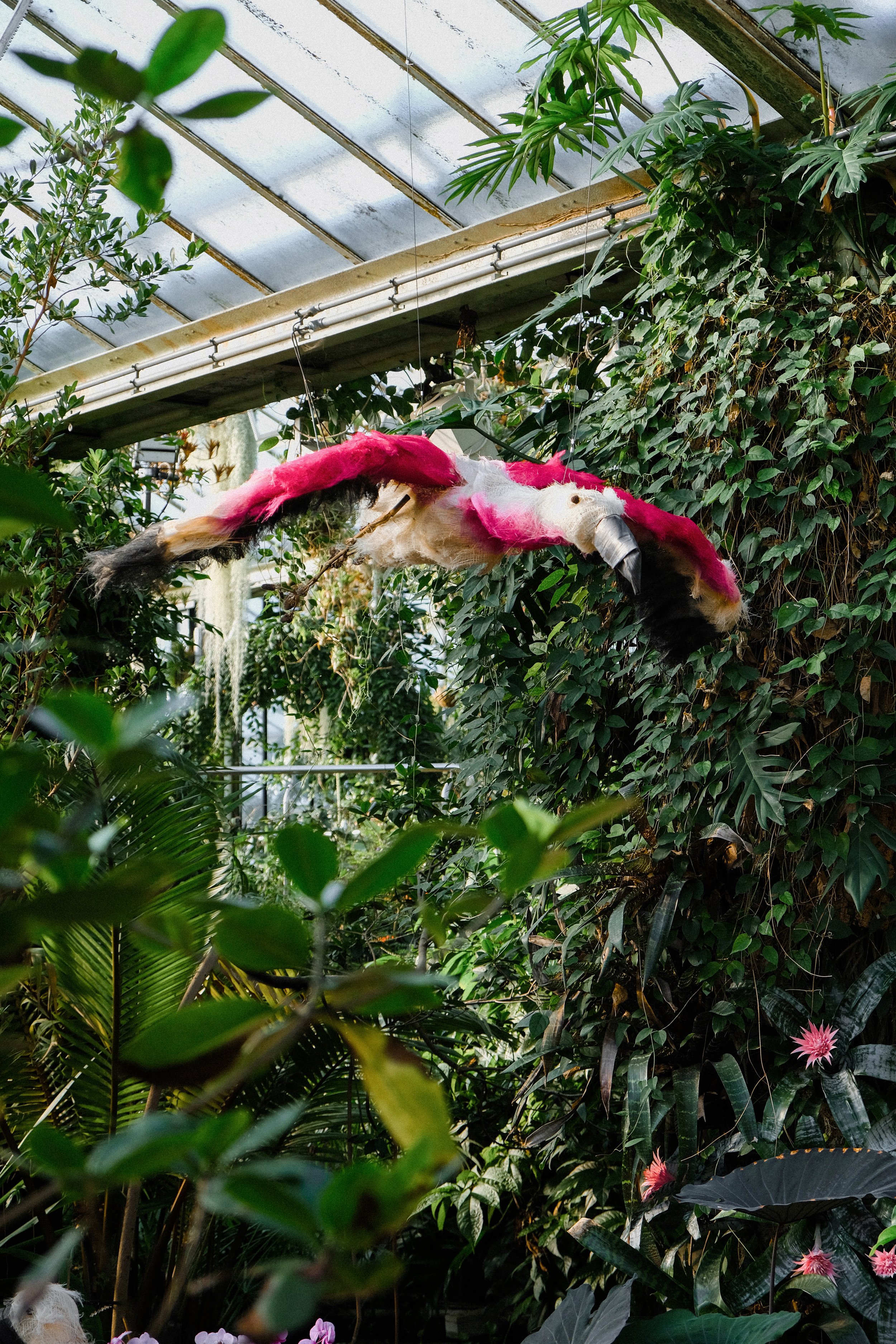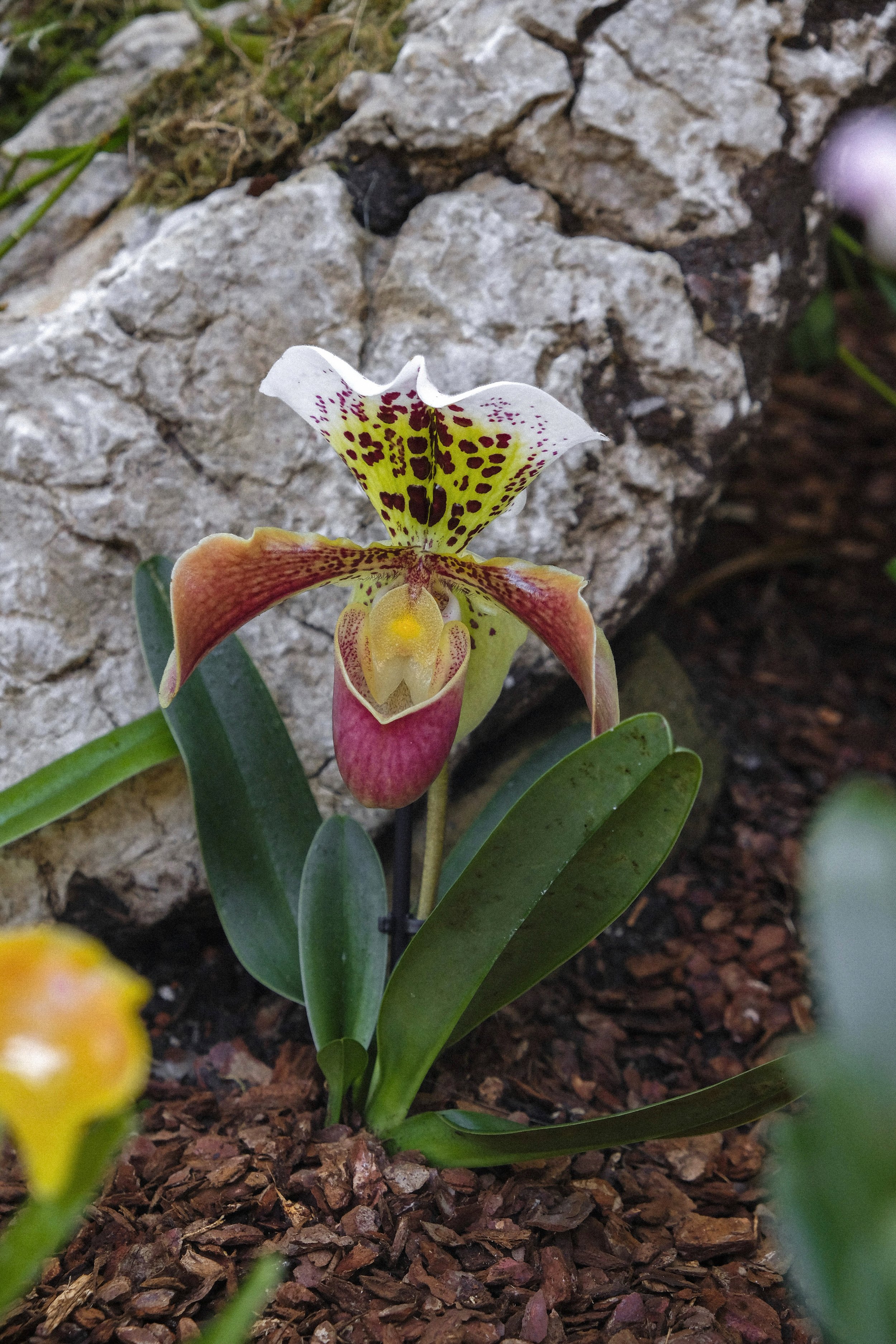The Orchid Festival at Kew Gardens
Last year we enjoyed our first encounter with Kew Garden’s annual Orchid Festival (which you can read about here), and we knew that we would have to make it a yearly tradition, especially after taking out membership. Every February, Kew drenches the Princess of Wales Conservatory in a cacophony of tropical colours with their annual celebration of orchids. The festival, with its unapologetic celebration of vibrant flora, brings cheer to the oft-grey slog of winter months. Last February we visited on a day of torrential rain and bleak cloud but this year we were treated to crystal blue skies and full sun which shone through the glasshouse and illuminated an already sparkling display of colour.
The Princess of Wales Conservatory is the perfect setting to explore the diversity of orchids, a flower species found in almost every habitat on Earth, because it presents the chance to travel the world within a single glasshouse. A verdant labyrinth leads you through a series of fascinating ecosystems and ten climate zones, including dry and arid landscapes where cacti thrive, humid regions great for tropical fauna and wet zones where giant waterlilies float. While the orchids are the star of the show, the glasshouse also boasts a plethora of other amazing plants, including the vibrant flowers of the jade vine.
This year’s festival was inspired by the dazzling landscape of Peru. Peru conjures deep, dark, steaming jungles thanks to a marmalade-loving bear. While Peru certainly has its fair share of dense rainforests, it boasts a whole range of biodiverse and culturally rich topographies, including snow-capped mountainscapes, arid deserts, verdant forests and rugged coastlines. The festival celebrated Peru’s varied and valuable ecology, geography and botany.
As you enter the glasshouse your senses were immediately immersed. Along the route were information cards explaining aspects of Peruvian culture, history and landscape, alongside photographs taken by Mariano Vivanco portraying Ancient Peruvian civilisations. We learnt about the Nazca Lines, a group of 358 known geoglyphs (Earth drawings) spanning a huge area in southern Peru’s Nazca Desert. They were made by the Nazca peoples between 200 BC and AD 650 and are thought to symbolise agriculture and fertility. The exhibition also introduced the Moche and Chimu civilisations – two significant empires in Andean history as well as the famous Incans, the largest empire in Pre-Columbian America. Accompanying the route through Peruvian’s past was a fabulous soundtrack curated by Marie Castro of Pisco Disco, celebrating the lively, rhythmic and energetic sound of Amazonian cumbia.
The whole festival is a feast for the eyes as orchids in all shapes, sizes, colours, and markings dot the route but the festival is also an opportunity to learn more about the ground-breaking research undertaken by Kew scientists to help us better understand the natural world. We learnt more about Peru’s biodiversity and climate change challenges through the research on a little-known crop called papapaq chuñu in Quechua. This grows high up in the Andes and is the focal point of a new research project investigating the bitter potato’s genetic makeup. The research is not only important from a scientific standpoint but from a human one too. The climate crisis places crops like this in a vulnerable situation, impacting Indigenous farming communities. This research subsequently helps Peruvian farmers and Indigenous cultivators to adapt and protect their ancestral food sovereignty. Another fascinating area of study shared during the exhibition was that of the mysterious island-like ecosystems called lomas. The coast of Peru is one of the driest deserts in the world, yet thanks to thick seasonal fog that rolls in off the cold Pacific Ocean, life thrives in these lomas. Home to a unique flora that has adapted to survive under extremely harsh summer conditions, lomas habitats are also extremely hard to study. Researchers from Kew, alongside a group of trained paramotorists from Britain and Brazil, embarked on a project to document the flora and fauna of this hard to reach topography. Just over halfway through the tour, you’re able to view a short film about these impressive research endeavours. Another plaque provided information about the process of pollination and orchids’ important role in these vital processes. There are 10,000 or so orchid species that use deception to lure insect pollinators by sight or scent. Some Peruvian species, known as perfume orchids, have evolved chemically based scents to attract only male bees of the tribe Euglossini, usually referred to orchid bees. Male bees seek out these perfume orchids not to find food but to cover themselves in the orchid’s scent, which smells exactly like the pheromones that stimulate females for mating. This ecological collaboration helps both the bee and orchid populations.
The most flamboyant and breath-taking display of orchids takes centre stage in the greenhouse’s pond. This year a dazzling cornucopia, flanked by a wicker vicuña and an Andean cock-of-the-rock, sprays hundreds of orchids into your eye view. Inspired by the Peruvian coat of arms, this display features a vicuña – the wild ancestor of domesticated alpacas – and a cinchona tree, also known as the ‘fever tree’ thanks to its use in treating malaria. Tropical birds are suspended from the rafters, alongside clusters of colourful orchids. Many of Peru’s orchids grow in forests teeming with life where an array of bird species sing, squabble and chatter and the display certainly celebrates this cohabitation of flora, fauna and animals. The next pond displays an Andean cloud forest of pink orchids, of which a flock of flamingos from Lake Titicaca graze. In the distance Peru’s most iconic landmark – Machu Picchu – could be seen.
The orchid festival is the product of a year’s planning. Kew’s extensive orchid collection dates back to 1787 when William Aiton, Kew’s head gardener at the time, successfully persuaded a clamshell orchid from Central America to flower in the UK for the first time. Today Kew’s orchid collection holds over 10,000 plants, representing around 1,600 species and other varieties. The captivating beauty of an orchid is hard to deny and the festival celebrates every colour, shape and size under the sun. Magentas, deep oranges, buttery yellows, violets, mauves, maroons, lime greens, caramels and crimsons stand out at every turn. Some are pointed, others rounded, some resemble spider legs, others boast threatening spots. It is difficult to choose a favourite and excited chatter fills the air as visitors point out what they have spotted.
One of the final installations of the tour is that of white orchids, representing a pair of towering Puya raimondii mature and fully grown being enjoyed by hummingbirds. This species is endemic to the harsh Andean highlands of Peru and Bolivia. During our visit a melodic birdsong filled the air. Initially we thought it was part of the soundtrack but it was actually a robin serenading his audience. Just after the Puya raimondii was a charming bear sculpture. The Bosque de Protección Alto Mayo is a protected area and home to charismatic spectacled bears and Peru’s national bird, the Andean cock-of-the-rock. The last installation celebrates Peru’s 2,400 km coastline stretching along the Pacific. The display represents a baby whale shark to commemorate the protected status Peru granted these underwater giants in 2017.
After the orchids we headed for lunch at the Conservatory Café before sating our other love – art – in the Shirley Sherwood Gallery. The exhibition celebrated the incredible ceramic vessels of Felicity Aylieff. Inspired by the botanical illustrations and trees of Kew, Aylieff created a series of monumental works, all hand-thrown and hand painted during her longstanding collaboration with the porcelain production workshops and artisan craftspeople of Jingdezhen, China. They are a towering testament to the centuries-old traditions which established Jingdezhen as the ‘Porcelain Capital’ of the world.
Some of the most visually impressive artworks of the exhibition are the 5-metre-tall vases painted using a vibrant range of cobalt blue oxides in a technique known as Qing Hua, a signature of Aylieff’s work. While these installations are certainly magnificent, we were particularly drawn to the smaller Fencai enamel vessels. These works feature stylised illustrations of cyclamen, tulips, lilies, irises, peonies and many more beautiful blooms. The exhibition – Expressions in Blue – was a wonderful conclusion to a day full of beauty.
Before heading home we had a quick explore of the Temperate House, enjoying the last of the day’s sun with a walk around the balcony to gaze down at a sea of green amidst the elegance of this Grade I listed building. We also saw Kew’s resident fox, who is always a joy to spot.
We look forward to catching the magnolia and blossom that frame Kew’s Palm House during early spring, followed by the greenery of the summer months.









































